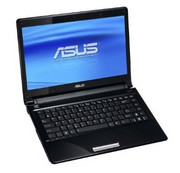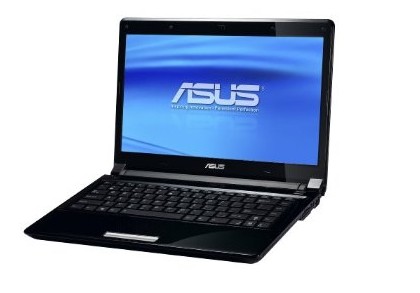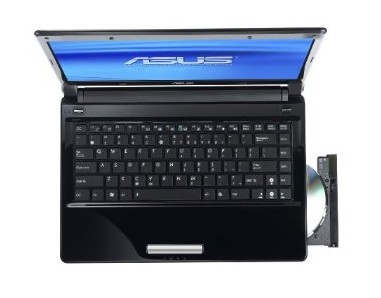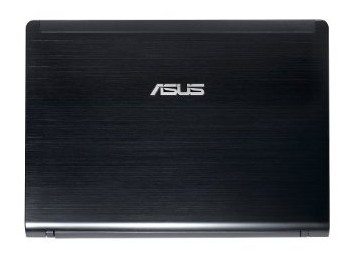Asus UL80Vt
Especificações do Portátil

Price comparison
Média de 6 pontos (das 7 análises)
Análises para o Asus UL80Vt
Origem: AnandTech
 EN→PT Archive.org version
EN→PT Archive.org versionWe've already discussed our thoughts on the UL80Vt and G51J - you can read the details on pages two and three. Both are great laptops, and while we didn't give either the coveted Gold award they are closer than we've come in quite some time. For those that are wondering, anything earning a Bronze Editors' Choice is (at least in my mind) a 90% score; Silver means 93%, and Gold means 95% or higher. Basically, Gold awards are reserved for unequivocal recommendations, and we do have a few minor complaints with both of these laptops, mostly oriented around the LCDs.
Análise única, Disponível online, Longa, Data: 12/15/2009
Pontuação: Pontuação total: 94%
Origem: Good Gear Guide
 EN→PT Archive.org version
EN→PT Archive.org versionASUS' UL80Vt is a 14in notebook that's built for people who want plenty of features and good speed, yet want a laptop that's reasonably light and capable of lasting a long time away from a power outlet. If a reasonably thin and light notebook with excellent battery life sounds like your cup of tea, then the ASUS UL80Vt is for you. At 14in it's easy to use, yet not a burden to carry around. It's well built, looks good and performs well, but it does lack some connectivity options such as eSATA.
Análise única, Disponível online, Média, Data: 12/14/2009
Pontuação: Pontuação total: 80%
Origem: Hot Hardware
 EN→PT Archive.org version
EN→PT Archive.org versionThe UL80Vt isn't perfect though. While the keyboard was stellar and the multi-touch aspect of the trackpad were a plus, we still aren't into the dimpled pad and the glossy LCD. For those working outdoors, this screen could potentially be a major nuisance. Also, the relatively low 1366x768 resolution is nothing to write home about, and the slower 5400rpm (320GB) hard drive isn't all that quick when it comes time to boot or load applications for the first time. Still, we think the positives far outweigh the negatives when all things are considered. For just over $800, this is a really well-rounded machine.
Análise única, Disponível online, Muito longa, Data: 11/25/2009
Pontuação: preço: 90% desempenho: 80% pantalha: 40% mobilidade: 80% emissões: 90%
Origem: Computer Shopper
 EN→PT Archive.org version
EN→PT Archive.org versionIf you need an everyday laptop that offers portability and a full list of features at a reasonable price, look no further than the Asus UL80Vt. It’s the best 14-inch thin-and-light available for the price ($849 list, or around $825 on the street), delivering no-excuses performance—including surprising 3D-gaming chops—plus battery life when you need it, all in a sleek, slim design. Long battery life and good performance help make the feature-packed UL80Vt today's best under-$1,000 thin-and-light.
Análise única, Disponível online, Longa, Data: 11/01/2009
Pontuação: Pontuação total: 87%
Origem: Magnus.de
 DE→PT Archive.org version
DE→PT Archive.org versionAnálise única, Disponível online, Média, Data: 03/08/2010
Pontuação: Pontuação total: 100%
Origem: Notebookjournal
 DE→PT Archive.org version
DE→PT Archive.org versionAnálise única, Disponível online, Muito curta, Data: 12/03/2009
Pontuação: Pontuação total: 90% preço: 80% desempenho: 70% características: 30% pantalha: 30% mobilidade: 70% processamento: 70% ergonomia: 70%
Origem: Retera
 RU→PT Archive.org version
RU→PT Archive.org versionAnálise única, Disponível online, Longa, Data: 03/10/2010
Pontuação: Pontuação total: 71% desempenho: 44% pantalha: 58% mobilidade: 72% emissões: 44%
Comentario
NVIDIA GeForce G210M: AT Nvidia GeForce G210M ou G 210 M é uma placa gráfica DirectX 10.1 para portáteis baseada no núcleo GT218 core. Assim como sua predecessora ela apresenta 16 shaders mas a velocidade do clock foi muito aumentada. Devido ao processo de 40nm (comparado com o processo de 55nm da G110M) o consumo máximo de energia permanece o mesmo.
Estes processadores gráficos podem mostrar fluidamente só jogos antigos. Jogos atuais só podem ser apresentados com detalhes substancialmente reduzidos.
>> Mais informação pode ser encontrada na nossa Comparativa de de Placas de Vídeo e a Benchmark Lista.
Intel Core 2 Duo: Este é o sucessor do Core Duo e o Core Solo com um pipeline mais longo e com 5-20% a mais de velocidade sem maior consumo de energia. Adicionalmente ao design do Core Duo existe um quarto decodificador, uma unidade SSE ampliada e uma unidade lógica aritmética (ALU) adicional.
Os Core 2 Duo para notebooks são idênticos aos processadores Core 2 Duo para desktops, mas os processadores para notebooks trabalham com tensões mais baixas e um Frontside bus clock mais baixo. O desempenho de notebooks igualmente clocked é 20-25% mais baixo que PCs Desktop por causa do Frontside bus clock mais baixo e os discos rígidos mais lentos.
SU7300: Processador dual core de baixa freqüência com um TDP baixo de 10 Watts.
>> Mais informação pode ser encontrada na nossa Comparativa de Processadores Móveis.







